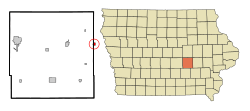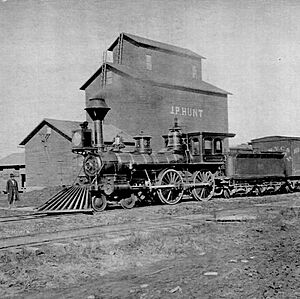Victor, Iowa facts for kids
Quick facts for kids
Victor, Iowa
|
|
|---|---|

Storefronts in Victor, Iowa
|
|

Location of Victor, Iowa
|
|
| Country | |
| State | |
| Counties | Iowa, Poweshiek |
| Area | |
| • Total | 0.48 sq mi (1.25 km2) |
| • Land | 0.48 sq mi (1.25 km2) |
| • Water | 0.00 sq mi (0.00 km2) |
| Elevation | 810 ft (247 m) |
| Population
(2020)
|
|
| • Total | 875 |
| • Density | 1,819.13/sq mi (702.06/km2) |
| Time zone | UTC-6 (Central (CST)) |
| • Summer (DST) | UTC-5 (CDT) |
| ZIP code |
52347
|
| Area code(s) | 319 |
| FIPS code | 19-80805 |
| GNIS feature ID | 0462561 |
Victor is a small town located in Iowa! It sits across two counties: Poweshiek and Iowa counties. In 2020, about 875 people lived here. This was a little less than the 952 people who lived in Victor in 2000.
Contents
History of Victor
Before European settlers arrived, the area around Victor was home to the Sac and Fox Native American tribes.
A path called the Dragoon Trail runs near Victor. It follows the route of the first U.S. Dragoons, who were mounted soldiers. They explored Iowa in 1835 after the Black Hawk Purchase of 1832. This trail went through the Bear Creek Valley, about a mile south of where Victor is now.
In 1856 and 1857, Mormon Handcart Pioneers used the Dragoon Trail. They were traveling from Iowa City to the Salt Lake Valley in Utah. This route was later known as the "State Road." Today, it's called "A Diagonal" by the county. Later, until about 1863, Mormon pioneers passed through Victor in covered wagons.
Founding the Town
In April 1854, a man named George W. Wilson bought the land where Victor now stands. He was from Ohio.
In October 1861, Wilson moved from Ohio to Iowa for good. He started talking with Thomas C. Durant, a railroad leader from New York City. They agreed that Wilson would give land for the railroad. This land would be used for tracks, a switch yard, and a station. A building called a depot would also be built there.
Building the depot started on November 15, 1861. It was finished by December 24. Some building materials came from Wilson's own timber land near Victor. Other supplies were bought from Davenport and Iowa City. Samuel Howard was the boss, and he had many workers helping him. They prepared and moved the wood needed for the building.
The depot was the very first building in what would become Victor. It helped the town start to grow.
On May 5, 1863, Joseph A. Blackburn, who was George Wilson's brother-in-law, officially created the town. It was first named "Wilson" to honor George Wilson. More land was added to the town on June 19, 1866, and again on December 20, 1867.
In 1869, the town officially became a city under Iowa's laws. George Wilson and a surveyor named Charles Stotwell divided the town into smaller pieces of land called lots. The town had been measured out just eight years before it became a city.
Name Change and Early Settlers
In July 1854, the first post office in the area opened south of Victor. It was on the State Road and was named "Victor" after a village in New York. In 1865, the post office moved to the new town. At that time, the town's name was changed from Wilson to Victor.
A man named McEckley was the first to build a house, a store, and a mill in Victor. Early settlers came from places like Ohio, Indiana, and Maryland. Many of them were from Irish and German families. Later, people from Belgium and the Czech Republic also moved to Victor.
Railroad History
The first railroad to reach Victor was the Mississippi and Missouri Railroad (M&M Railroad) in 1862. This railroad was Iowa's very first, started in 1853. Its goal was to connect Davenport on the Mississippi River to Council Bluffs on the Missouri River. It was also the first railroad west of the Mississippi River to be connected by a bridge to the East Coast. This railroad was important for building the first transcontinental railroad across the country.
The Rock Island Line bought the M&M Railroad on July 9, 1866.
Victor's Location
Victor is located at 41°43′49″N 92°17′50″W / 41.73028°N 92.29722°W. The city covers about 0.49 square miles (1.25 square kilometers) of land. There is no water area within the city limits.
Population of Victor
| Historical population | |||
|---|---|---|---|
| Census | Pop. | %± | |
| 1880 | 352 | — | |
| 1890 | 616 | 75.0% | |
| 1900 | 612 | −0.6% | |
| 1910 | 640 | 4.6% | |
| 1920 | 802 | 25.3% | |
| 1930 | 794 | −1.0% | |
| 1940 | 763 | −3.9% | |
| 1950 | 741 | −2.9% | |
| 1960 | 870 | 17.4% | |
| 1970 | 949 | 9.1% | |
| 1980 | 1,046 | 10.2% | |
| 1990 | 966 | −7.6% | |
| 2000 | 952 | −1.4% | |
| 2010 | 893 | −6.2% | |
| 2020 | 875 | −2.0% | |
| U.S. Decennial Census | |||
2020 Population Details
In 2020, Victor had 875 people living in 379 households. About 243 of these were families. The city had about 1,818 people per square mile. There were 417 homes in total.
Most of the people in Victor were White (94.9%). A small number were Black or African American (1.3%), Native American (0.3%), or Asian (0.2%). About 1.4% of the population was Hispanic or Latino.
About 27.2% of households had children under 18 living there. The average age in Victor was 41.4 years old. About 24.7% of residents were under 20 years old. The population was almost evenly split between males (50.6%) and females (49.4%).
Famous People from Victor
Victor has been home to several notable people:
- William Lawrence Adrian was a priest in Victor who later became a Bishop.
- Ben Beran, born in Victor, was a basketball player.
- Jackie Collum, born in Victor, was a professional baseball pitcher.
- John W. Gwynne, born in Victor, became a U.S. Representative.
- Leonard Raffensperger, born in Victor, was a football coach at the University of Iowa.
- Albert M. Sackett, born in Victor, became a U.S. admiral.
Education in Victor
The H-L-V Community School District runs the public schools in the Victor area.
Healthcare in Victor
People in Victor can get healthcare at the Victor Health Center Clinic. If someone needs to go to a hospital, the closest one is Compass Memorial Healthcare in Marengo, Iowa.
Rolle Bolle Game
Victor has two courts for a game called Rolle Bolle. One court is indoors at The 214 Bar and Grill. The other is outdoors next to the post office. This yard game came from Belgium, where it's called krulbollen. Belgian immigrants brought it to the United States a long time ago. Many people in Victor still play Rolle Bolle today. It's also played in nearby towns like Belle Plaine, Clutier, Marengo, Ladora, and Blairstown.
Victor Rolle Bolle Mural
A large mural about Rolle Bolle overlooks Victor's outdoor courts. From 2014 to 2016, about a dozen students from HLV High School worked on it. They used black and white paints to copy four old photos. They put these photos together to make one big picture. The finished mural was shown for the first time on June 25, 2016, during Victor Fun Day. It was just before a Rolle Bolle tournament started. The mural shows many people who played the game.
Images for kids
See also
 In Spanish: Victor (Iowa) para niños
In Spanish: Victor (Iowa) para niños





